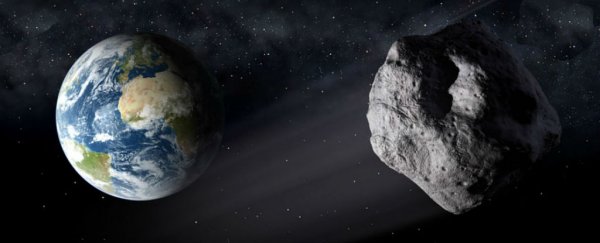A 30-metre asteroid is expected to zip past Earth some time between March 5 and 8, and while it's an awesome reminder that yes, we are part of a buzzing, chaotic cosmic neighbourhood filled with all kinds of things that could crash into us, asteroid 2013 TX68 is by no means a threat.
"There is no concern whatsoever regarding this asteroid - unless you were interested in seeing it with a telescope," says Paul Chodas, manager of NASA's Centre for Near-Earth Object Studies (CNEOS). "Prospects for observing this asteroid, which were not very good to begin with, are now even worse, because the asteroid is likely to be farther away, and therefore dimmer than previously believed."
The closest asteroid 2013 TX68 is expected to get to Earth during this week's flyby is around 5 million kilometres (3 million miles), and while there's a chance that its orbit could get it closer than that, the absolute minimum distance between us and that whale of a space rock is 24,000 kilometres (15,000 miles), so your doomsday bunker can stay locked for another day.
If you noticed something weird in that sentence, great job: high fives. Yep, there's a huge difference between 5 million kilometres and 24,000 kilometres, so why can't NASA do a better job at mapping out asteroid 2013 TX68's orbit?
Well, first off, the scientists who are watching this particular asteroid managed to identify it way back in 2013, when it was about 1.5 million kilometres away from Earth (that's nearly four times farther than the Moon), so just knowing it exists is an achievement in itself.
They've struggled to pin down its orbit since because 2013 is the only time anyone has ever actually seen this asteroid, which means figuring out where its orbit will place it this week relies on a whole lot of educated guesswork.
Astronomer Phil Plait explains over at Slate:
"Think of it this way. Imagine you're an outfielder in a baseball game. You see the pitcher throw the ball, and the batter swings. It's a hit! But one-tenth of a second after the batter makes contact, you close your eyes. Now, based on the fraction of a second you saw the ball move, can you catch it?
I would be willing to bet a lot of money you won't. You weren't able to watch the ball long enough to get a good fix on its direction, its speed, its position. It could land next to you, or it could fall 40 metres away, or it could be knocked right out of the park. The only way to catch it would be to keep your eyes on it, observe it as long as possible until you can be completely sure of where it's headed."
While the exact distance from Earth asteroid 2013 TX68 will reach this week is up for debate, depending on how you interpret the data we have on its trajectory, its danger-factor is unequivocally zero.
"We already knew this asteroid, 2013 TX68, would safely fly past Earth in early March, but this additional data allow us to get a better handle on its orbital path," said Chodasin a NASA press release. "The data indicate that this small asteroid will probably pass much farther away from Earth than previously thought."
In fact, NASA has announced that while the asteroid is of note because of its scheduled flyby, there is no way it can impact Earth for at least the next century. We'll 'see' it again around 28 September 2017, when it'll have less than a 1 in 250 million chance of impacting us. We like those odds.
So spare a thought for our far-out space pal, asteroid 2013 TX68, this weekend. It's so freaking lonely out there in the vast expanse of the Universe, it's nice to send our inanimate neighbours some good thoughts when we can.
